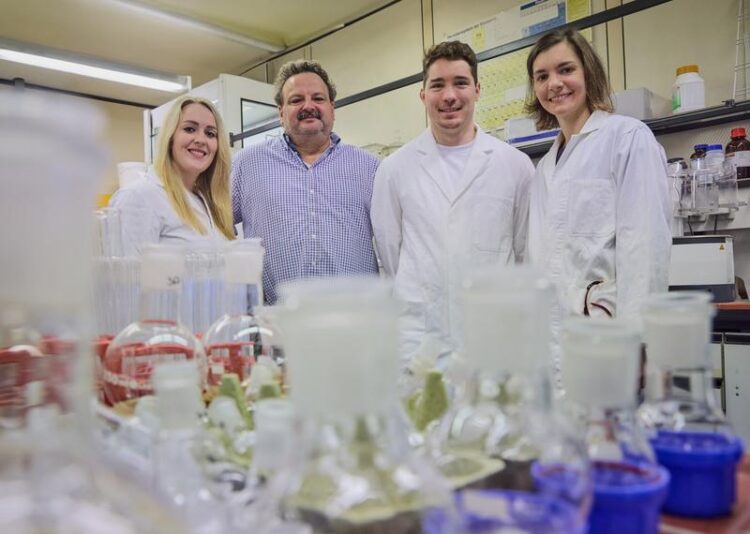Turning One into Eight

The team of the Kekulé Institute for Organic Chemistry and Biochemistry: (from left) Katharina Pieper, Prof. Dr. Andreas Gansäuer, Christian Köhler and Regine Mika from the Kekulé Institute for Organic Chemistry and Biochemistry at the University of Bonn.
Photo: Volker Lannert / Universität Bonn
To synthesize potential drugs or natural products, you need natural substances in specific mirror-image variants and with a high degree of purity. For the first time, chemists at the University of Bonn have succeeded in producing all eight possible variants of polypropionate building blocks from a single starting material in a relatively straightforward process. Their work has now been published in the prestigious journal “Angewandte Chemie.”
Polypropionates are natural products that can help save lives. They are needed to make reserve antibiotics, compounds that are only ever used to treat infections caused by drug-resistant bacteria. In nature, chiral compounds exist in two different variants that share the same molecular formula but are mirror images of each other, like a right and a left hand. Chemists call this “chirality,” which literally means “handedness.” “What’s interesting is that the mirror-image forms can have very different properties,” explains Professor Andreas Gansäuer from the Kekulé Institute of Organic Chemistry and Biochemistry at the University of Bonn. “One well known example is undoubtedly carvone. The dextro-, or ‘right-handed,’ form of this molecule smells of caraway, while its levo-, or ‘left-handed,’ form is what gives peppermint its distinctive odor.”
Many drugs also contain molecules whose mirror-image forms have divergent properties. “The different properties also cause different effects inside the human body, so it’s vital to use the right form in a drug,” says Gansäuer, who is also a member of the Matter Transdisciplinary Research Area at the University of Bonn. “Although polypropionates occur naturally, we need them in a high degree of selectivity—i.e. in a specific variant—and with a high level of purity to use them in drug manufacture,” he adds, pinpointing the problem. “Up until now, however, the process for making synthetic polypropionates has been complicated and time-consuming.”
He and his team have now come up with a method that allows the desired variants to be produced with ease. “We’re able to make eight different variants from a single starting material, an alcohol in this case,” Gansäuer reveals. Polypropionates are chemical compounds consisting of hydrocarbon chains with an alternating sequence of methyl and hydroxyl groups. “The different substituents attached to the three carbon atoms on the chains give us a total of eight different forms that we call isomers of our polypropionate building blocks.”
The researchers from the University of Bonn used two known methods for creating the first four precursors to the eight isomers and added a new one, known as hydrosilylation: “The isomers are produced by us adding either fluoride for the dextro-form or titanium for the levo-form.” The process is similar to how branches form on a tree. It all starts at the trunk, in this case the alcohol, from which two branches split off first of all. This produces an epoxide—a three-membered ring structure containing an oxygen atom—in mirror-image variants. Two more branches are formed from these first two by adding an olefin, a carbon-carbon double bond, to each. In the final step, known as the hydrosilylation of epoxides, a total of eight branches split off from these four.
The technique has several benefits: “Our method works at room temperature,” says a happy Gansäuer. “Some of the classical reactions have to be carried out at very low temperatures. Also, we don’t need to use precious metals as catalysts any more, meaning that our method is more sustainable.”
He continues: “Our work will be able to be used as the basis for synthesizing drugs. When you’re manufacturing medicines, you never know in advance what form of a substance you’ll need. Substance screening often involves testing thousands of isomers to identify the right compound. If you can produce eight different forms, as shown here, you’ll also be able to make as many other interesting substances as you want, making it more likely you’ll find an effective structure.”
Funding
The work was funded by the German Research Foundation (DFG).
Wissenschaftliche Ansprechpartner:
Prof. Dr. Andreas Gansäuer
Kekulé-Institute of Organic Chemistry and Biochemistry University of Bonn
Phone: +49 228 73-2800
Email: andreas.gansaeuer@uni-bonn.de
Originalpublikation:
Katharina Pieper, Robin Bleith, Christian Köhler, Regine Mika and Andreas Gansäuer: “A Flexible Synthesis of Polypropionates via Diastereodivergent Reductive Ring-Opening of Trisubstituted Secondary Glycidols,” in: “Angewandte Chemie.” DOI: https://doi.org/10.1002/anie.202317525
Media Contact
All latest news from the category: Life Sciences and Chemistry
Articles and reports from the Life Sciences and chemistry area deal with applied and basic research into modern biology, chemistry and human medicine.
Valuable information can be found on a range of life sciences fields including bacteriology, biochemistry, bionics, bioinformatics, biophysics, biotechnology, genetics, geobotany, human biology, marine biology, microbiology, molecular biology, cellular biology, zoology, bioinorganic chemistry, microchemistry and environmental chemistry.
Newest articles

Innovative 3D printed scaffolds offer new hope for bone healing
Researchers at the Institute for Bioengineering of Catalonia have developed novel 3D printed PLA-CaP scaffolds that promote blood vessel formation, ensuring better healing and regeneration of bone tissue. Bone is…

The surprising role of gut infection in Alzheimer’s disease
ASU- and Banner Alzheimer’s Institute-led study implicates link between a common virus and the disease, which travels from the gut to the brain and may be a target for antiviral…

Molecular gardening: New enzymes discovered for protein modification pruning
How deubiquitinases USP53 and USP54 cleave long polyubiquitin chains and how the former is linked to liver disease in children. Deubiquitinases (DUBs) are enzymes used by cells to trim protein…



